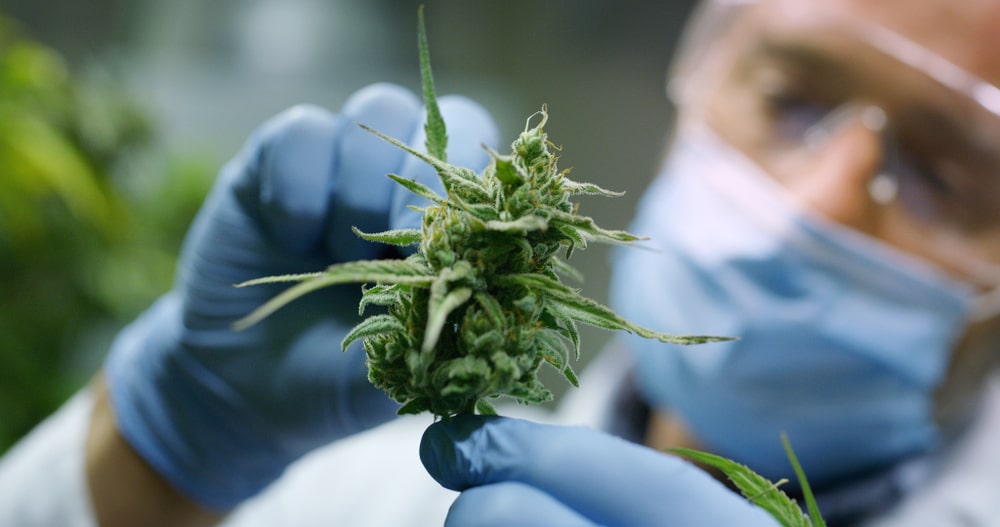Factors Influencing Cultivation of Medicinal Plants: The most important parameter is factors on which the growth, variation of plant species depends. It also affects the quantity of the medicinally active compounds present in the plants and this greatly depends on the plant size. The variation depends on various factors (Fig.1).
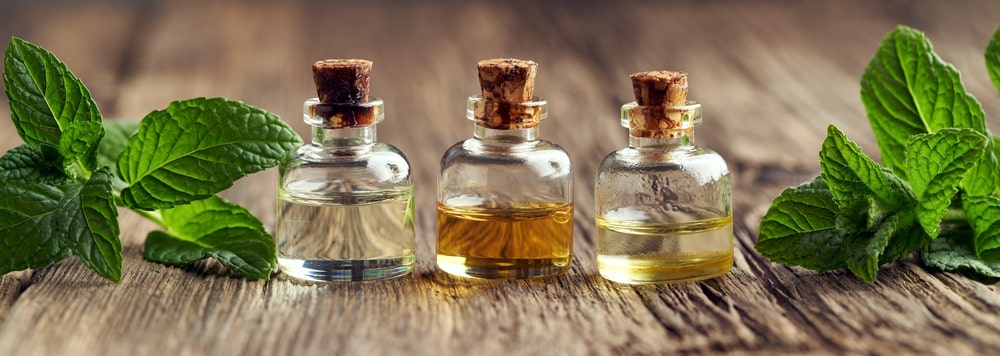
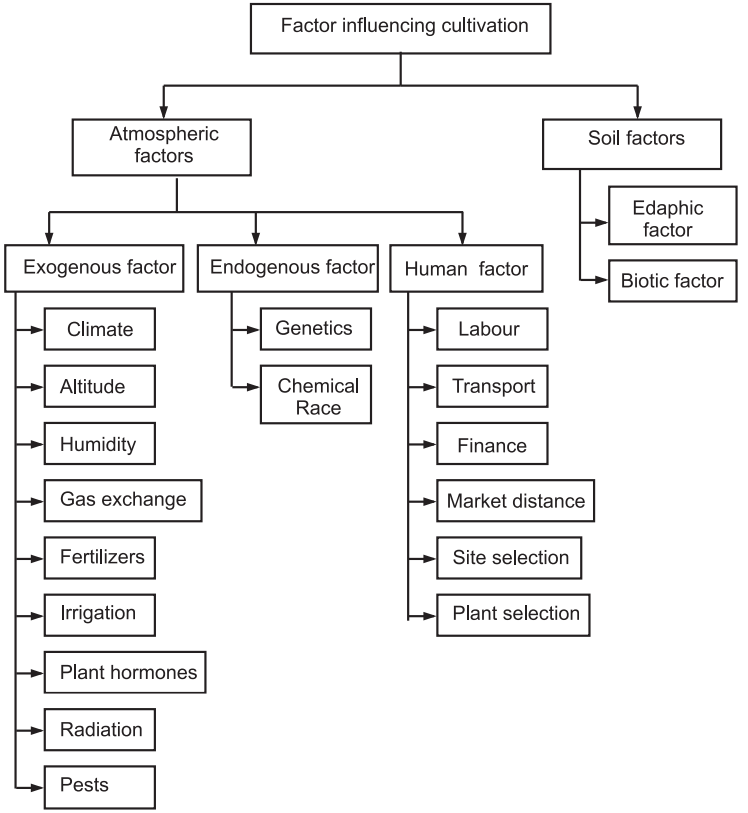
An auxanometer is an apparatus for measuring the increase or rate of growth in plants.
Atmospheric Factors
Table of Contents
Exogenous Factors
Climate and Light:
The plant should be cultivated in conditions that are similar to the plant’s natural habitat. Hence climate that is temperature, rainfall and length of the day, plays an important role in the growth of plants. Different crops require different climatic patterns. Most of the plants can grow well in sunny, dry conditions.
Examples: In cloudy weather, the amount of carbohydrates in leaves is decreased, since photosynthesis is light-dependent. As carbohydrates serve as the initial starting material for biosynthesis, their abundance affects the number of secondary metabolites. Temperature changes may also influence plant growth by affecting the rate of chemical reactions. Excessive temperature, as well as frost, also affects the growth, quality and metabolism of the medicinal plants. High temperature leads to the death of the plants and low temperature infects the plants with microorganisms. Alkaloids content becomes lower in Datura stramonium during cloudy/rainy weather, volatile oils are produced more readily in warmer weather, yet very hot days lead to a physical loss of oil; growing peppermint in shade rather than the sun. The contents of alkaloids in Stramonium leaves are lower in rainy and cloudy weather. For seed, the germination temperature should be 15–20°C. The optimum temperature for propagation is 18–28°C in which the day temperature should be 21–27°C and the night temperature 15°C.
Latitude and Altitude:
The effect of latitude is important in fat producing plants. Tropical plants (palm oil, cocoa butter) contain mainly saturated fatty acids, while the subtropical plants give a larger amount of unsaturated acids. The olive, almond and sesame oils are predominant in oleic acid. The plants of temperate zones (Cottonseed, sunflower) also contain more unsaturated acids. Peanut and olive trees grown in the subtropics have a higher unsaturated fat content.
Examples: Cinchona succirubra grows well at low levels but alkaloids are not produced. The bitter constituents of Gentiana lutea are increased with altitude. The alkaloids of Aconitum napellus and Lobelia inflata and the oil content of Thyme and Peppermint decrease with altitude. Pyrethrum gives the best yields of flower-heads and pyrethrins at high altitudes on Equator (East Africa).
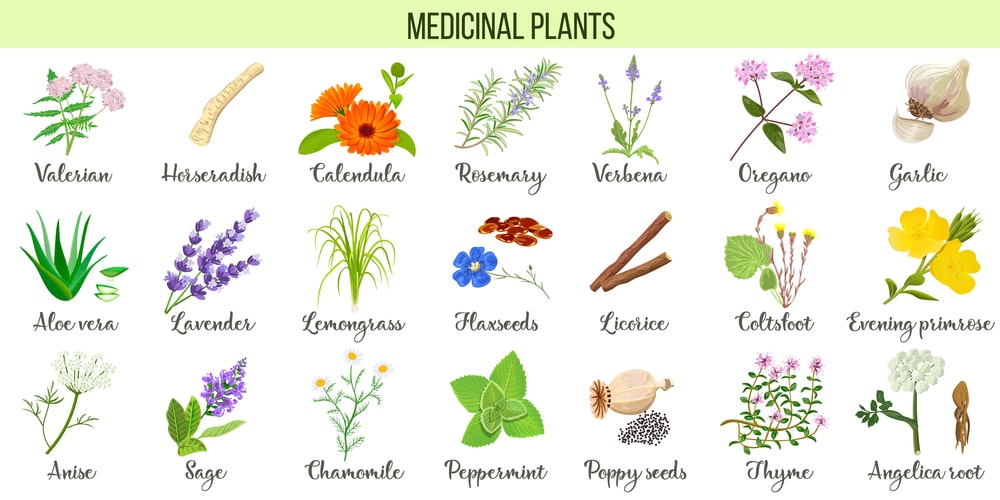
Humidity:
Humidity refers to the amount of vapour that the air holds at a given time. It is usually expressed as a percentage of the maximum amount of water vapour that the air will hold at current temperatures. There are three main measurements of humidity: absolute, relative and specific. Absolute humidity is the water content of the air. The relative humidity is the ratio of actual water vapour content to the saturated water vapour content at a given temperature and pressure expressed in percentage (%). Specific humidity is a ratio of the water vapour content of the mixture to the total air content on a mass basis. Humidity has a major impact on the overall performance and final yield of the plants grown indoors.
Examples: Optimum Humidity for plant growth is 50-80%; high humidity encourages the spread of fungal diseases, whereas low humidity increases transpiration. The mean maximum relative humidity occurs in the early morning, whereas the mean minimum, relative humidity occurs in the early afternoon. There are various devices used to measure and regulate humidity. A device used to measure humidity is called a psychrometer or hygrometer. Relative humidity (RH) directly influences the water relations of plants and indirectly affects leaf growth, photosynthesis, pollination, the occurrence of diseases and finally economic yield. The dryness of the atmosphere as represented by saturation deficit (100-RH) reduces dry matter production through stomatal control and leaf water potential.
Gas exchange:
To carry on photosynthesis, green plants need a supply of carbon dioxide and a means of disposing of oxygen. To carry on cellular respiration, plant cells need oxygen and a means of disposing of carbon dioxide. Roots stem and leaves respire at rates much lower than are characteristic of animals. Only during photosynthesis are large volumes of gases exchanged and each leaf is well-adapted to take care of its own needs. Oxygen and carbon dioxide also pass through the cell wall and plasma membrane of the cell by diffusion. A high respiration rate occurs with seed germination and during advantageous root formation at the base of cuttings, so it requires more oxygen and removal of CO2. The exchange of oxygen and carbon dioxide in the leaf occurs through pores known as stomata. The gas exchange will occur through the moist epidermal layers of the young roots. Oxygen from the soil will diffuse into the cells while carbon dioxide diffuses out of the cells into the soil. In lower plants (and also protozoans) exchange of gases takes place through the general body surface as they are not highly modified or specialized. Also, the body surface allows the diffusion of gases.
Fertilization:
Fertilizer dosage has to be dependent on growing media. Soilless mixes have a lower nutrient holding capacity and therefore require more frequent fertilizer application. Essential elements are at their maximum availability in the pH range of 5.5 to 6.5. In general, microelements are more readily available at lower pH ranges, while macroelements are more readily available at pH 6 and higher. Recently nano-fertilizers are demanded improvement of the crop yield. Nano-fertilizers may be defined as nanoparticles, which can directly/augment the supply of essential nutrients for plant growth, have higher nutrient use efficiency and can be delivered on time to a rhizosphere target or by foliar spray.
Examples: Slow release nano nitrogen fertilizer: Nano zeolite impregnated with urea causes the slow and steady release of N. NH+ ions occupying the internal channels of zeolite slowly set free N allowing progressive absorption by the medicinal plants.
Slow-release nano phosphate fertilizer: Surface modified zeolite (SMZ) is a good sorbent for PO-3 and slow release of P is achievable.
Uptake of nano micronutrients: Application of Zn nanoparticles (< 100 nm) at a relatively lower level (0.28 ppm) enhanced the growth of maize plant as compared to normal zinc sulphate (0.5 ppm). The plant height, root growth and volume, dry matter weight can also improve with the application of zinc oxide nanoparticles.
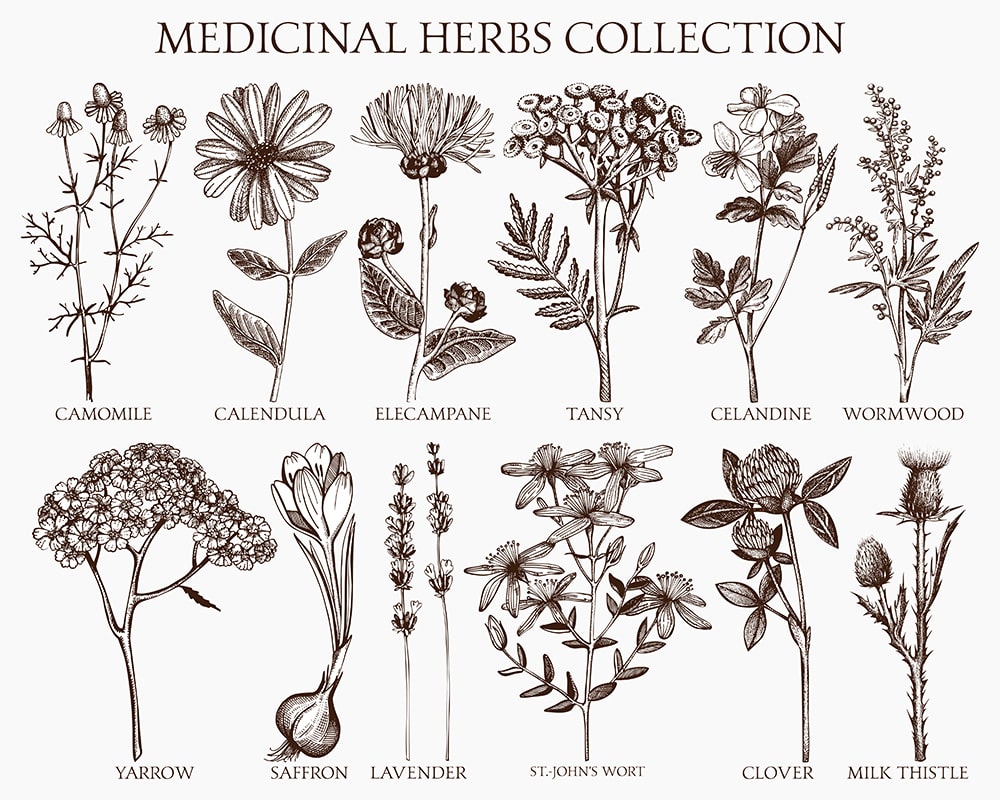
Irrigation and drainage:
Irrigation and drainage should be controlled and carried out by the needs of the individual medicinal plant species during its various stages of growth. Water used for irrigation purposes should comply with local, regional and/or national quality standards to ensure that the plants under cultivation are neither over- nor under-watered. First light irrigation is required during land preparation and initial sowing of the seeds. It gives a fast germination rate to get plantlets.
Plant hormones:
Plant hormones are signal molecules produced within the plant cells. They occur in extremely low concentrations but exert strong control over plant development. They act either locally or in a more distant part of the plant. There are several types of plant hormones available viz. auxin, gibberellin, cytokinin, ethylene and abscisic acid. These hormones work together or independently to influence plant growth.
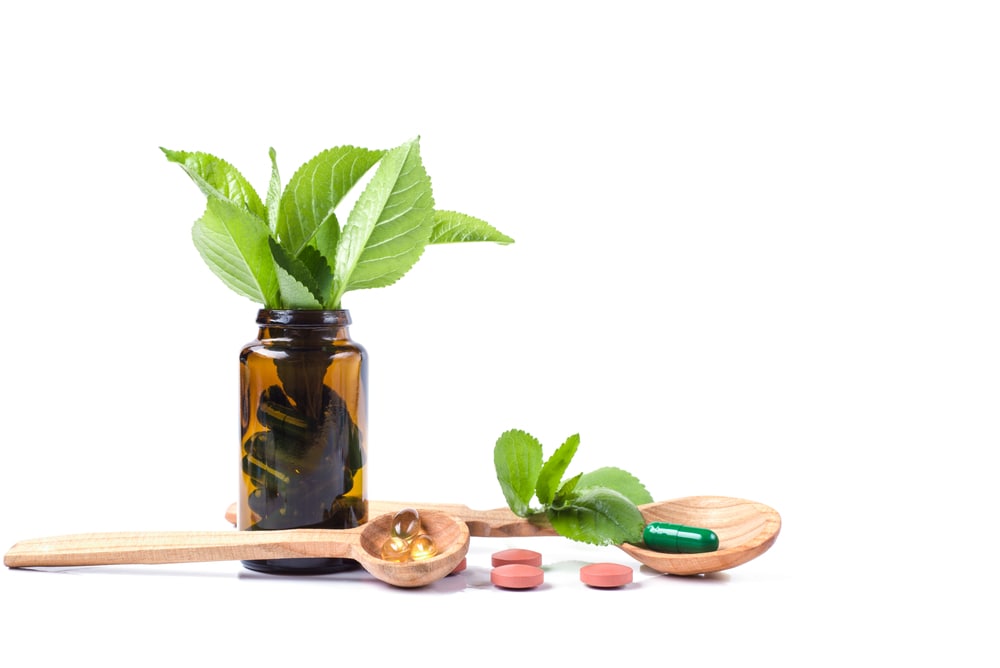
Radiation:
Solar radiation plays an important role as a regulator and controller of growth and development. Solar energy provides light required for seed germination, leaf expansion, growth of stem and shoot, flowering, fruiting and thermal conditions necessary for the physiological functions of the plant. Solar radiation also influences the assimilation of nutrient and dry matter distribution. Plants require solar radiation for photosynthesis and their growth rate is proportional to the amount received, assuming that other environmental parameters are not limiting. Visible light is a composite of wavelengths between 400 and 700 nanometers (nm) and this specific waveband is defined as PAR (Photosynthetically Active Radiation). PAR consists of wavelengths that are utilized by the plant’s biochemical processes in photosynthesis to convert light energy into biomass. Light energy can also be defined in radiometric units, which is measured with a pyranometer. Solar radiation may be measured in radiometric units (Wm-2) to determine its total energy value, or it may be measured in quantum terms (mmol s-1 m-2) for calculation of the amount of sunlight specifically available for plant growth during a specific growth period (mol m-2). Radiation energy has three components (a) quality (b) intensity and (c) duration of light. They influence the physiological process of the plants for healthy growth. The quality (wavelength and colour), quantity (the intensity and duration of exposure to light) greatly influence plant growth. Quality refers to wavelength and colour. Of the total range of electromagnetic wavelengths in the solar spectrum, light or luminous energy includes wavelengths between 400- 750 mm (millimicrons) or nm (nanometers). The quantity of light is measured in g cal/ m2 /year. Lux: It is the luminous flux per unit area which is equal to one lumen per square metre. The intensity of light has many effects on the uptake of phosphorus and potassium. Oxygen intake increases with the increase of light intensity. Some species of plant produce more active constituents at night like Nicotiana tobacco; Ocimum basilicum grown in glasshouses have less phenol and terpenoids in the leaves. Based on the reaction to the photoperiod, the plants are classified as short day, long day and intermediate day plants. Short day plant: Tobacco, menthofuran; long day: grains, menthone, menthol; intermediate day: cotton.
Pests:
Reduction in the quantity of the crude drugs also depends on the pests and their attack. The huge losses due to pest infestation tune to lakhs of rupees every year due to less medicinal values. Pests are detrimental for the plants and thus controlling them during the cultivation of medicinal plants is essential. These pests include fungi, viruses, weeds, insects and rodents (non-insect pests). Examples of fungal pests are Pythium spinosum (rhizome rot), Currularia prasad (leaf blight), Septoria digitalis (leaf spot), Cercospora rauwolfia (leaf spot) etc. Fungus on henbane lowers the alkaloid content. Some of the viruses like tobacco mosaic virus, cucumber mosaic virus and tobacco ringspot virus attack the digitalis plant. Several insects can also cause problems in the growth of the plants, e.g., Diaphania Nilgiris attack Rauwolfia plant, Phytomyza tricorn has attacked Menthe plants etc. Weeds are also considered dreadful pests that are undesired plants. They can resist the growth of the original plants. Some weeds also cause allergies e.g., hey fever caused by ragweed, asthma caused by parthenium etc. Non-insect pests like rats, monkeys, birds, snails, mites, crabs also spoil the stored crude drugs.
There are some methods available to control the pests:
1. Mechanical method: During preliminary stages, they can be controlled by handpicking, pruning, burning and trapping.
2. Agricultural method: Advanced breeding techniques are capable of gene manipulation in different stages of plant growth to get disease-free healthy plants. These methods include hybridization, polyploidy, mutation and chemical races. To control weeds, ploughing should be deep as possible so that up-rotation of the weeds is possible. Crop rotation also helps to minimize the attack of the pests.
3. Biological control: This is a very useful method by combating pests with other living organisms. For example, the chemical substances produced (7,8-epoxy-2- methyloctadecane) and released by the gipsy moth are capable to elicit a sexual response from the opposite sex and that can control the pests. Mexican brittle can control the parthenium by sucking the root sap of parthenium weeds; Australian ladybug feeds on damaging insect called cottony cushion scale insect on citrus crop etc.
4. Chemical control: The use of chemical pesticides also helps to control the pests like insecticides, fungicides, herbicides and rodenticides. When necessary, only approved pesticides and herbicides should be applied at the minimum effective level, by the labelling and/or package insert instructions of the individual product and the regulatory requirements that apply for the grower and the end-user countries.
Some examples are Rodenticides: Warfarin, strychnine red squill etc. Insecticides: DDT, parathion, gammaxine etc. Fungicides: Bordeaux mixture, chlorophenols etc; Herbicides: 2,4- dichloro phenoxy acetic acid, calcium arsenate etc.

Endogenous Factors
Genetic factors:
Genetic differences are responsible for morphological variety and biochemical diversity. Information on genetic divergence is essential for sustained genetic improvement of a crop. Genetic markers are used for the improvement of crop production. They represent genetic differences between individual organisms or species. Molecular markers are being increasingly used for divergence studies and are known as genotypic markers. They do not affect the phenotype of the trait of interest because they are located only near or linked to genes controlling the trait. All genetic markers occupy specific genomic positions within chromosomes called loci. They are of three types.
- Morphological markers, which themselves are phenotypic traits or characters.
- Biochemical markers, which include allelic variants of enzymes called isozymes.
- DNA markers, which reveal sites of variation in DNA. They are of three types: RFLP (Restriction Fragment Length Polymorphism), polymerase chain reaction based on RAPD (Random Amplified Polymorphic DNA) and DNA sequence-based on SNP (Single Nucleotide Polymorphism).
Application:
This method is
- used for characterization and identification of cultivars, varieties and natural populations;
- used to understand the genetic variability of the population;
- protects variety by fingerprinting;
- determines the phylogenetic relationships between species and
- assesses varietal uniformity.
Chemical races:
It is also known as chemodemes. They are regarded as a group of plants of a species that have identical morphological characters but differ in their chemical nature. Hence chemodemes are considered as chemically separate groups within species. The chemical characteristics of chemodemes are hereditary. Genotype and phenotype are together responsible for chemical races. Genotype refers to the genetic traits in an organism. Current methods of genotyping include restriction fragment length polymorphism identification (RFLP) of genomic DNA, random amplified polymorphic detection (RAPD) of genomic DNA, amplified fragment length polymorphism detection (AFLPD), polymerase chain reaction (PCR), DNA sequencing, allele-specific oligonucleotide (ASO) probes and hybridization to DNA microarrays or beads. Phenotype refers to observable, physical manifestations of an organism.
Examples: Withania somnifera has three chemical races, Chemotype I and II contain the same compounds withaferin and chemotype III contain withanolides, where both these active constituents have different medicinal actions. Chemical races have also been reported in Claviceps purpurea, Digitalis purpurea, Digitalis lanata, Cinnamomum zeylanicum, Ocimum sanctum etc.
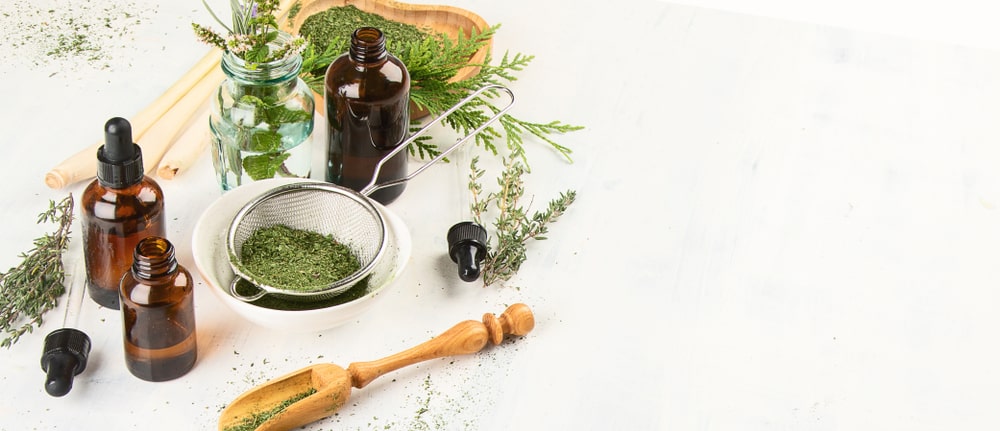
Human Factors
Labours:
All farms need either human labour or machinery to do the work. Some farm types use very little labour, e.g. sheep farming. Others require a large labour force, e.g., rice farming in India.
Market:
This is the customer who buys farm produce. Farmers need to sell their crops and animals to make a profit. Perishable crops such as soft fruits fetch a high price but need to be grown within a short travelling distance of the market.
Finance:
Profits are used to pay the wages and to re-invest in the farm e.g., buying seeds, fertilizer, machinery and animals. This is known as feedback within the farming system.
Transport:
Transportation is an economic factor in the production of goods and services, implying that relatively small changes can have substantial impacts on costs, locations and performance. It provides market accessibility by linking producers and consumers. Improvements in transportation and communication favour a process of geographical specialization that increases productivity and spatial interactions.
Site selection:
Medicinal plant materials derived from the same species can show significant differences in quality when cultivated at different sites, owing to the influence of soil, climate and other factors. These differences may relate to physical appearance or to variations in their constituents, the biosynthesis of which may be affected by extrinsic environmental conditions, including ecological and geographical variables and should be taken into consideration.
Selection of plants:
The species or botanical variety selected for cultivation should be the same as that specified in the national pharmacopoeia or recommended by other authoritative national documents. In the absence of such national documents, the selection of species or botanical varieties specified in the pharmacopoeia or other authoritative documents of other countries should be considered. In the case of newly introduced medicinal plants, the species or botanical variety selected for cultivation should be identified and documented as the source material used or described in the traditional medicine of the original country.
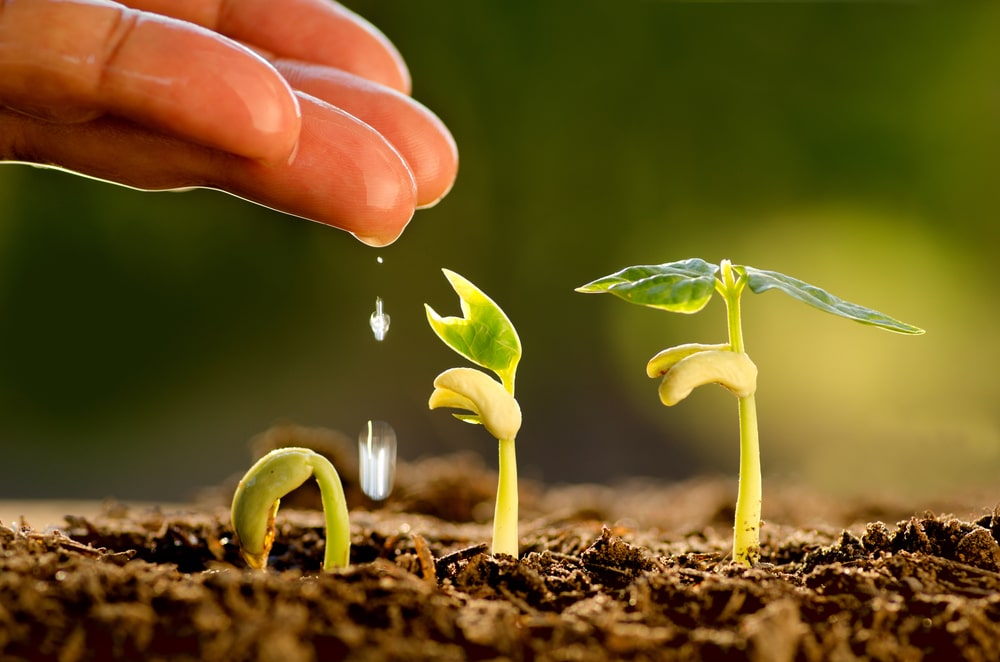
Soil Factors
Soil plays an important role in plant growth. It is classified into two types viz. edaphic and biotic factors (Fig.2).
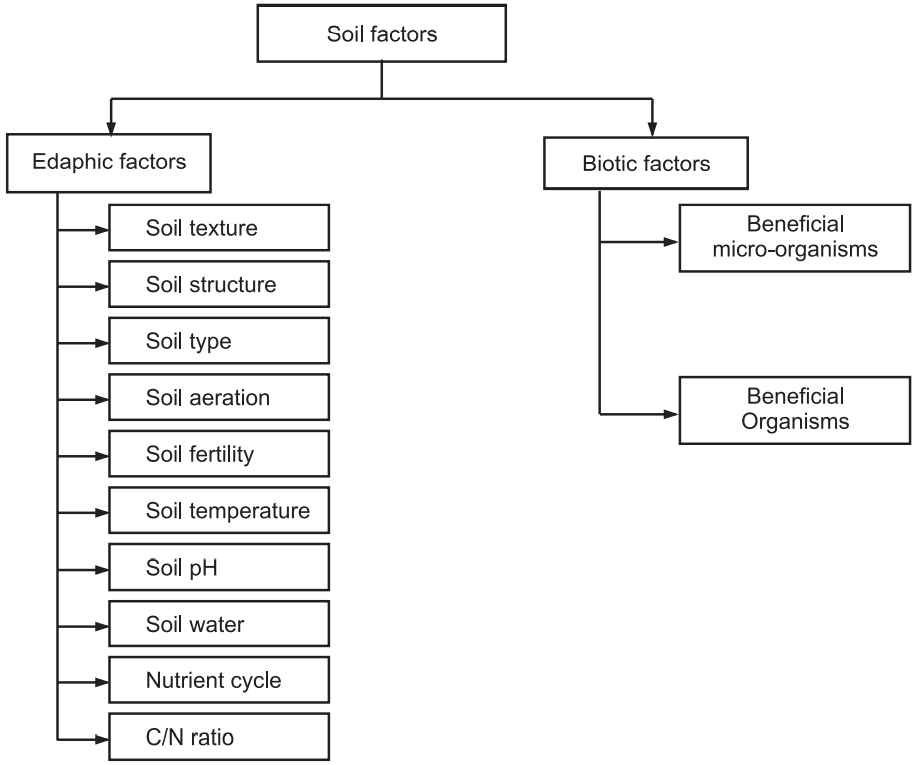
Edaphic Factors
Soil texture:
It is a qualitative rather than a quantitative tool; it is a fast, simple and effective means to assess the physical characteristics of the soil. It can be determined by the proportion of soil through sand, clay, silt and water holding capacity of the soil. This is used to determine crop suitability and to approximate the soil’s responses to environmental and management conditions such as drought or calcium (lime) requirements. Soil texture has an important role in nutrient management because it influences nutrient retention. For instance, finer-textured soils tend to have a greater ability to store soil nutrients. Knowing the soil texture alone will provide information about: (1) water flow potential, (2) water holding capacity, (3) fertility potential and (4) suitability for many urban uses like bearing capacity.
Soil structure:
Soil structure is the arrangement of soil particles into groupings. These groupings are called aggregates, which often form distinctive shapes typically found within certain soil horizons. For example, granular soil particles are characteristic of the surface horizon. Soil aggregation is an important indicator of the workability of the soil. Soils that are well aggregated are said to have “good soil tilth.” The various types of soil structures are given below:
Soil aggregates:
Generally, only very small particles form aggregates, which include silicate clays, volcanic ash, minerals, organic matter and oxides. There are various mechanisms of soil aggregation.
Mechanisms of Soil Aggregation:
- Soil microorganisms excrete substances that act as cementing agents and bind soil particles together.
- Fungi have filaments, called hyphae, which extend into the soil and tie soil particles together.
- Roots also excrete sugars into the soil that help bind minerals.
- Finally, soil particles may naturally be attracted to one another through electrostatic forces, much like the attraction between hair and a balloon.
- The soil structure greatly depends on the soil profile.
Soil profile: The soil profile is an important tool in nutrient management. By examining a soil profile, we can gain valuable insight into soil fertility. As the soil weathers and/or organic matter decomposes, the profile of the soil changes. The soil profile is made up of distinct layers, known as horizons. They are natural layers of the soil, which vary in thickness, depending upon the location and have somewhat irregular boundaries (Fig.3).
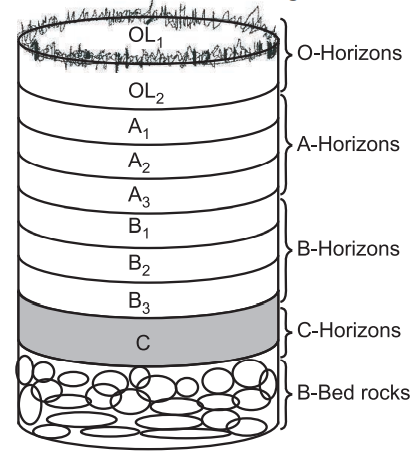
O horizon: The “O” stands for organic. It is a surface layer dominated by the presence of large amounts of organic material in varying stages of decomposition. The O horizon should be considered distinct from the layer of leaf litter covering many heavily vegetated areas, which contains no weathered mineral particles and is not part of the soil itself. It contains a high percentage of dead organic matter. This horizon is divided into OL1 and OL2 where OL1 contains decomposed matter (on the surface of the soil) and OL2 contains well-decomposed organic matter which is not visible.
A horizon: The A horizon is the top layer of the soil horizons or ‘top soil’. This layer has a layer of dark decomposed organic materials, which is called “humus”. “A” Horizons may be darker in colour than deeper layers and contain more organic material or they may be lighter but contain less clay or sesquioxides. This layer is subdivided into A1, A2 and A3. A2 layer is known as washing out of clay. A3 layer is the intermediate layer between A and B. On this horizon, most biological activity occurs. Soil organisms such as earthworms, pot worms (enchytraeids), arthropods, nematodes, fungi and many species of bacteria and archaea are concentrated here, often in close association with plant roots. Thus the A horizon may be referred to as the biomantle.
B horizon: The B horizon is commonly referred to as “subsoil” and consists of mineral layers which may contain concentrations of clay or minerals such as iron or aluminium oxides or organic material moved there by leaching. Accordingly, this layer is also known as the “illuviated” horizon or the “zone of accumulation”. This layer is also divided into three sub-layers viz. B1, B2 and B3. Plant roots penetrate through this layer, but it has very little humus. It is usually brownish or red because of the clay and iron oxides washed down from the A horizon.
C horizon: The C horizon is simply named so because it comes after A and B within the soil profile. This layer is little affected by soil-forming processes (weathering) and the lack of pedological development is one of the defining attributes. The C Horizon may contain lumps or more likely large shelves of unweathered rock, rather than being made up solely of small fragments as in the solum. “Ghost” rock structure may be present within these horizons. The C horizon also contains parent material. It forms the framework of the soil. The A and B layers are formed by this layer.
Bedrocks: This is the layer partially weathered at the base of the soil profile. Unlike the above layers, this layer largely comprises continuous masses (as opposed to boulders) of hard rock that cannot be excavated by hand. Soils formed in-situ will exhibit strong similarities to this bedrock layer.

Soil types:
Soil type usually refers to the different sizes of mineral particles in a particular sample. Soil is made up in part of finely ground rock particles, grouped according to size as sand and slit in addition to clay and hummus, organic material such as decomposed plant matter. The largest particles, sand, determine aeration and drainage characteristics, while the tiniest, sub-microscopic clay particles are chemically active, binding with water and plant nutrients. The ratio of these sizes determines soil type: clay, loam, clay-loam, silt-loam and so on.
Properties of Some Important Soils:
Sandy Soil:
- The soil is made of a greater proportion of big particles.
- They cannot fit closely together.
- There are large spaces between them. These spaces are filled with air.
- Water absorption is very high as the water passes quickly through these spaces.
- These soils are light, well-aerated and dry.
Clay Soil:
- It is made of a relatively high proportion of fine particles.
- They have very little space between particles.
- Water can be trapped in the tiny gaps between them due to their smaller size.
- Clay soils are heavy and hold more water.
Loamy Soil:
- It is a mixture of sand, soil and silt.
- Silt particles are present between the particles of sand and soil.
- This soil is considered the best for the growth of plants due to the presence of humus.
- The percolation rate is between sandy soil and clay soil.
The different types of Indian soil are:
Alluvial Soils: This includes the deltaic alluvium calcareous alluvial soils, Coastal alluvium and Coastal sands. It is the most important soil group of India contributing the largest share to its agricultural wealth. This soil is derived from the deposition laid by the numerous tributaries of the Indus, Ganges and the Brahmputra systems.
Black Soils: These soils vary in depth from shallow to deep. The typical soil derived from the Deccan trap is the “Regur” or black cotton soil. It is common in Maharashtra, Western parts of Madhya Pradesh, A.P., Gujarat and Tamil Nadu.
Red Soils: The ancient crystalline and metamorphic rocks on meteoric weathering have given rise to the red soils. The red colour is due to the wide diffusion of iron rather than to a high proportion of it. The soils comprise vast areas of Tamil Nadu, Karnataka, Goa, Daman and Diu, M. P., Orissa, Jharkhand, Bihar, West Bengal, U. P. etc.
Desert Soils: The most predominant component of this soil is quartz. Some of these soils contain a high percentage of soluble salts, high pH, a very high percentage of calcium carbonate, but are poor in organic matter.
Problem Soils: These are the soils that owing to land and soil characteristics, cannot be economically used for the cultivation of crops without adopting proper reclamation measures.
Laterite Soil: The soil is a mixture of hydrated oxides of aluminium and iron with a small amount of manganese. This soil is poor in lime, magnesia and nitrogen but high in humus, P2O5.
Acid Soils: Soils having pH below 7 are considered to be acidic, but those which have pH less than 5.5 and which respond to liming may be considered to qualify to be designated as acid soils. These occur widely in the Himalayan region, Ganges delta and Peninsula.
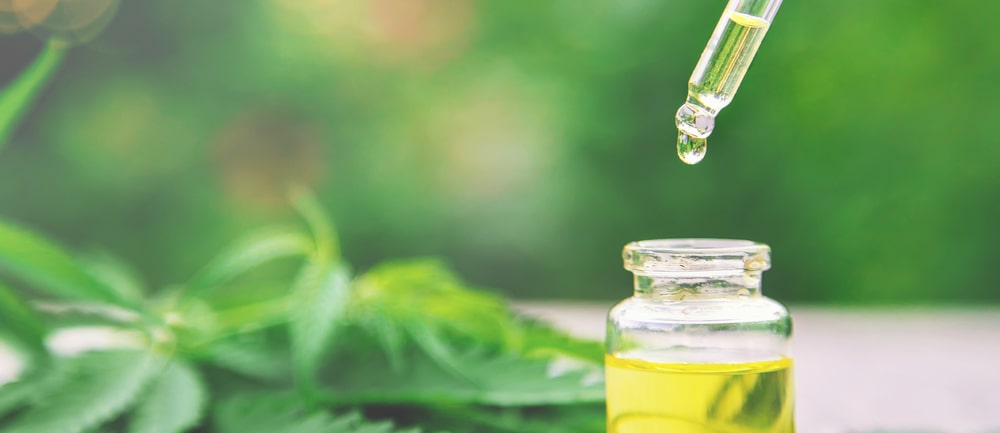
Soil aeration:
Soil aeration is the mechanism of the exchange of oxygen and carbon dioxide between soil pore space and the atmosphere to prevent the deficiency of oxygen and toxicity of carbon dioxide. Respiration by plant roots and microorganisms depletes oxygen and releases carbon dioxide and minute quantities of other gases into the soil atmosphere. The amount of carbon dioxide varies widely depending on temperature, organic matter and microbial respiration. A constant inflow of oxygen and outflow of carbon dioxide is essential for plant growth. Loosening dense soil facilitates the exchange of gases between soil air and the atmosphere. Air-filled pores commonly fluctuate from 15 to 30 per cent of the total volume depending upon water content, soil density and structure.
Causes of Poor Soil Aeration:
- Compact soil.
- Waterlogging.
- Soils having an excessive amount of readily decomposable organic matter.
- Harmful effects of poor aeration.
- Microbial activity is reduced, slow decomposition of organic matter.
- Rhizobium cannot symbiotically fix atmospheric nitrogen.
Soil fertility:
Soil fertility is a complex process that involves the constant cycling of nutrients between organic and inorganic forms in the soil. As plant material and animal wastes decompose, they release nutrients to the soil solution. These nutrients may then undergo further transformations which may be aided or enabled by soil micro-organisms. Natural processes such as lightning strikes may fix atmospheric nitrogen by converting it to NO2. Denitrification may occur under anaerobic conditions (flooding) in the presence of denitrifying bacteria. The cations, primarily phosphate and potash, as well as many micronutrients are held in relatively strong bonds with the negatively charged portions of the soil in a process known as cation exchange capacity. This helps in procuring the right fertilizers and choosing a suitable variety of seeds to get the highest possible crop productivity.
Characters of Soil Fertility:
- It is rich in nutrients necessary for basic plant nourishment. This includes nitrogen, phosphorus and potassium.
- It consists of adequate minerals such as boron, chlorine, cobalt, copper, iron, manganese, magnesium, molybdenum, sulphur and zinc. These minerals promote plant nutrition.
- The soil fertility pH is in the range of 6.0 to 6.8.
- It has a good soil fertility structure which results in well-drained soil fertility.
- It consists of a variety of microorganisms that support plant growth.
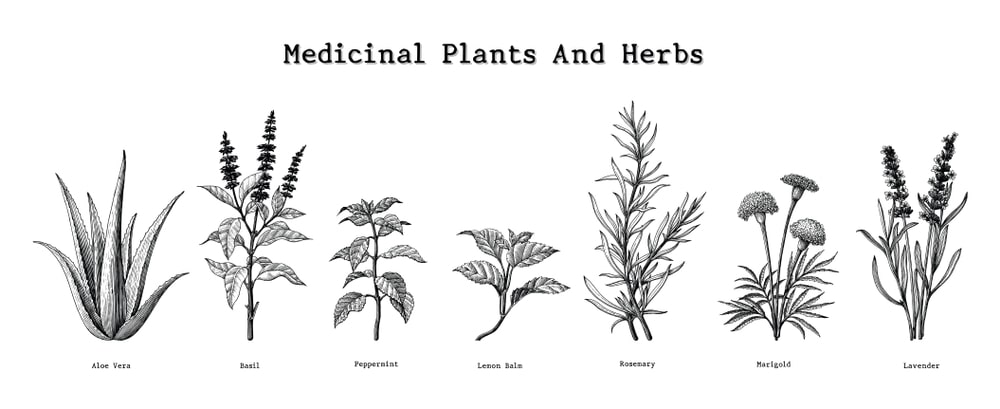
Soil temperature:
Soil temperature plays an important role in many processes, which take place in the soil such as chemical reactions and biological interactions. Soil temperature varies in response to exchange processes that take place primarily through the soil surface. These effects are propagated into the soil profile by transport processes and are influenced by such things as the specific heat capacity, thermal conductivity and thermal diffusivity. A denser and less reflective material increases the soil temperature by inhibiting evaporation. Soil temperature can serve as a useful guide for seeding operations. If the soil is too cool, germination is delayed, which results in seed damage and uneven or inadequate seedling emergence. Any thermometer that can measure temperature at a specific depth can be used to measure soil temperature.
Factors affecting Soil Temperature:
- Solar radiation: The amount of heat from the Sun that reaches the earth is 2.0 cal/cm2 min-1. The amount of radiation received by the soil depends on the angles with which the soil faces the Sun.
- Condensation: The heat increases whenever water vapour from soil depths or atmosphere condenses in the soil.
- Evaporation: The greater the rate of evaporation, the more the soil is cooled.
- Rainfall: Rainfall cools down the soil.
- Colour of the soil: Black coloured soils absorb more heat than light coloured soils. Hence, black colour soils are warmer than light coloured soils.
- Moisture content: A soil with higher moisture content is cooler than dry soil.
- Tillage: The cultivated soil has greater temperature amplitude as compared to the uncultivated soil.
- Soil texture: Soil textures affect the thermal conductivity of the soil. Thermal conductivity decreases with a reduction in particle size.
- Organic matter content: Organic matter reduces the heat capacity and thermal conductivity of soil, increases its water holding capacity and has a dark colour, which increases its heat absorbability.
Soil pH:
The soil pH is a measure of the acidity or basicity in soils. pH is defined as the negative logarithm (base 10) of the activity of hydronium ions (H+ or, more precisely, H3O+ aq.) in a solution. It ranges from 0 to 14, with 7 being neutral. A pH below 7 is acidic and above 7 is basic. The most common way of increasing soil pH is by applying agricultural lime. Soil pH is considered a master variable in soils as it controls many chemical processes that take place. It specifically affects plant nutrient availability by controlling the chemical forms of the nutrient. The optimum pH range for most plants is between 6 and 7.5. Manganese (Mn) is an essential plant nutrient, so plants transport manganese into leaves but manganese toxicity symptoms are seen at pH below 5.6. In slightly to moderately alkaline soils, molybdenum and macronutrient (except for phosphorus) availability is increased, but P, Fe, Mn, Zn Cu and Co levels are reduced and may adversely affect plant growth. In acidic soils, micronutrient availability [except for Molybdenum (Mo) and Boron (Bo)] is increased. Concentrations of available N are less sensitive to pH than the concentration of available phosphorus (P). For P to be available for plants, soil pH needs to be in the range of 6.0 and 7.5. If pH is lower than 6, P starts forming insoluble compounds with iron (Fe) and aluminium (Al) and if pH is higher than 7.5, P starts forming insoluble compounds with calcium (Ca). Most nutrient deficiencies are avoided between a pH ranges of 5.5 to 6.5. Soil pH is determined by using a soil pH meter.
Soil water:
The rate of absorption is different for different types of soils. This phenomenon of absorption of water by soil is termed percolation.
Percolation rate (mL/min): Amount of water/percolation time.
Nutrient cycle:
The continuous recycling of nutrients into and out of the soil is known as the nutrient cycle. The cycle involves complex biological and chemical interactions. A simplified version of this cycle of plant growth has two parts: “inputs” that add plant nutrients to the soil and “outputs” that export them from the soil largely in the form of agricultural products. Nutrients are exported from the field through harvested crops and crop residues, as well as through leaching, atmospheric volatilization and erosion. The difference between the volume of inputs and outputs constitutes the nutrient balance. Positive nutrient balances in the soils (occurring when nutrient additions to the soil are greater than the nutrients removed from the soil) indicate that farming systems are inefficient and, in the extreme, that may be polluting the environment. Negative balances indicate that soils are being mined and that farming systems are unsustainable over the long term.
C/N ratio:
The C/N ratio (C : N) or carbon-to-nitrogen ratio is a ratio of the mass of carbon to the mass of nitrogen in a substance. It is used in analyzing sediments and compost. carbon-to-nitrogen ratios are an indicator of the nitrogen limitation of plants and other organisms. For practical agricultural purposes, compost should have an initial C/N ratio of 20-30 : 1. Examples: For soil microbes, the C/N ratio is 4 : 1 to 9 : 1; soil organic matter: 10 : 1 to 12 : 1 etc.
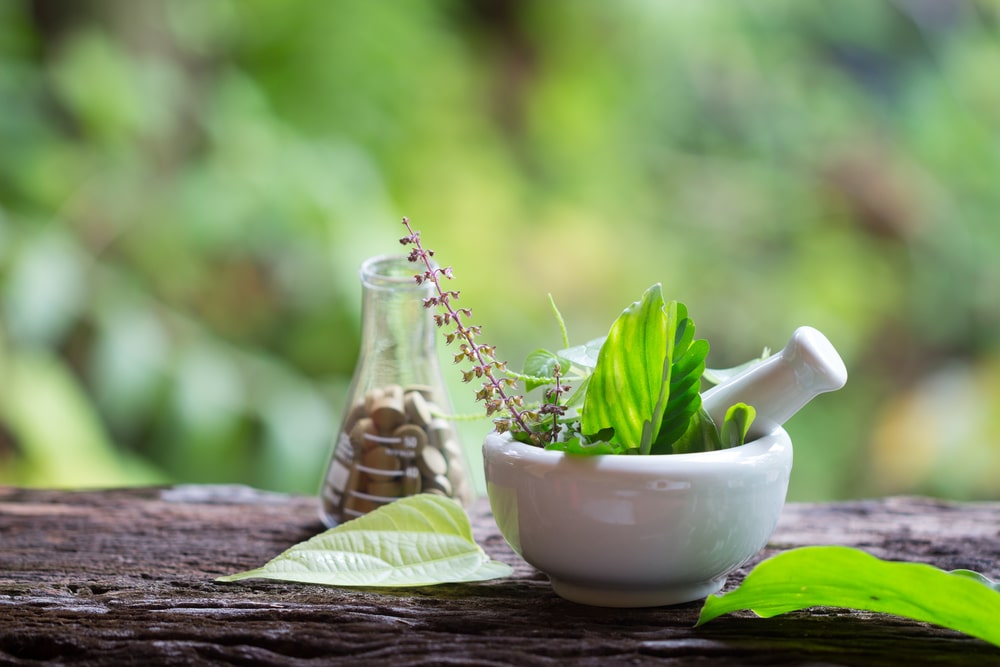
Biotic Factors
A biotic factor is defined as a factor created by a living thing or any living component within an environment in which the action of the organism affects the life of another organism. For example, a predator consuming its prey. A beneficial organism is any organism that benefits the growing process, including insects, arachnids, other animals, plants, bacteria, fungi, viruses and nematodes.
Beneficial soil microorganisms:
Microorganisms play a major role in the plant-soil relationship, particularly in the rhizosphere, i.e. the interface between root and soil. The majority of fungi and bacteria present in soils are considered to be beneficial to higher plants by (a) direct association with roots (mycorrhizae, nodule forming bacteria); (b) breakdown and release of minerals from organic matter present in the soil resulting in essential element availability increased to higher plants; (c) parasitizing harmful or disease-causing microorganisms or (d) suppressing growth, reproduction or activity of harmful disease-causing microorganisms through other interactions such as chemical inhibition. They stimulate plant growth, help mineral nutrition and water uptake, fix nitrogen, protect plants against parasites. Mixed culture of beneficial microorganisms such as photosynthetic bacteria (Rhodopseudomonas sp), lactic acid bacteria (lactobacillus sp.), yeast (saccharomyces sp.) and fermenting fungi positively improve the soil fertility as well as plant productivity.
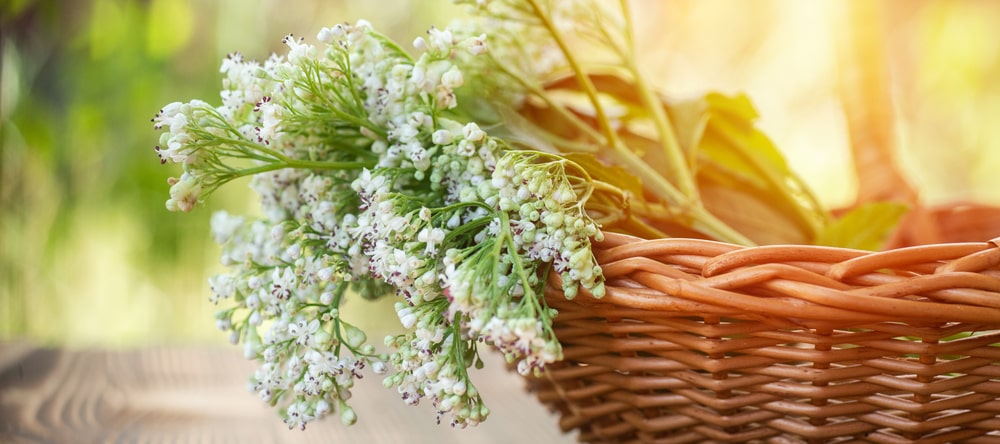
Beneficial organisms:
Insects: Beneficial insects can include predators (such as ladybugs) of pest insects and pollinators (such as bees, which are an integral part of the growth cycle of many crops). Increasingly certain species of insects are managed and used to intervene where natural pollination or biological control is insufficient, usually due to human disturbance of the balance of nature. Arachnids, Chalcids and Ichneumon Wasps are small beneficial insects that destroy leaf-eating caterpillars.
Make sure you also check our other amazing Article on : Cultivation and Collection of Drugs of Natural Origin
